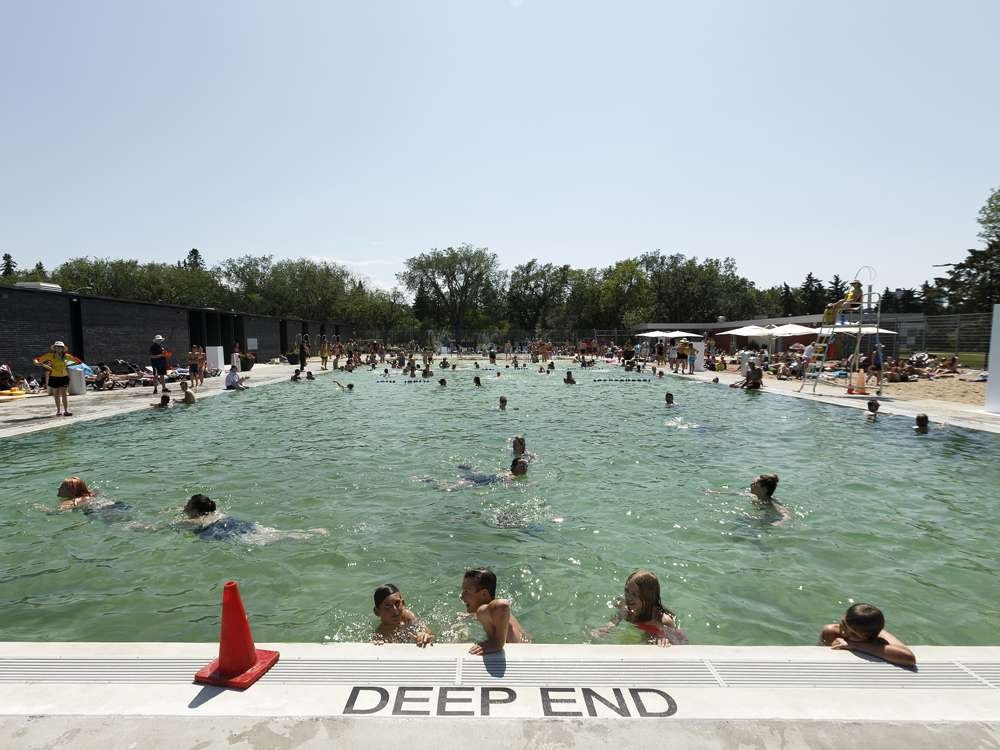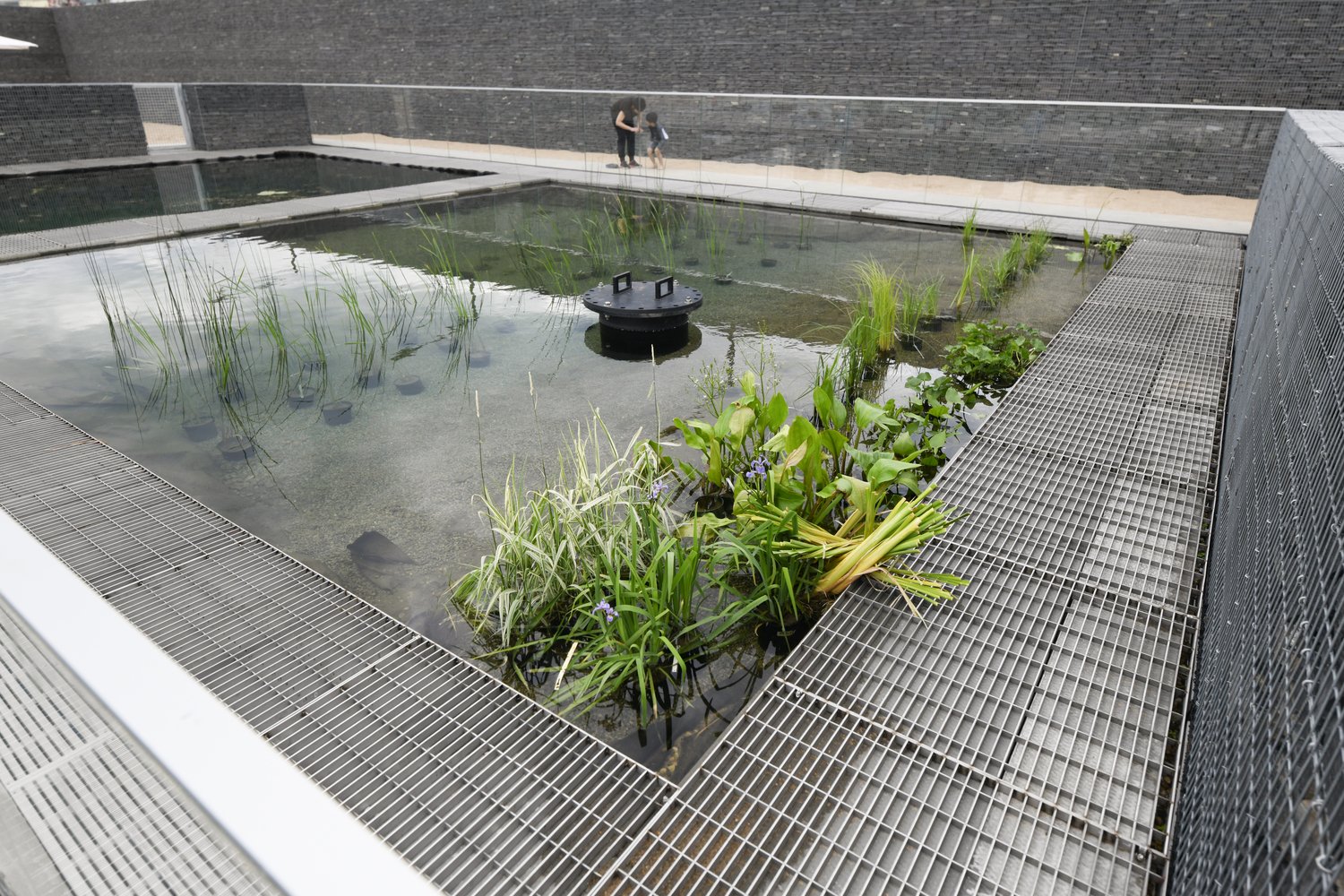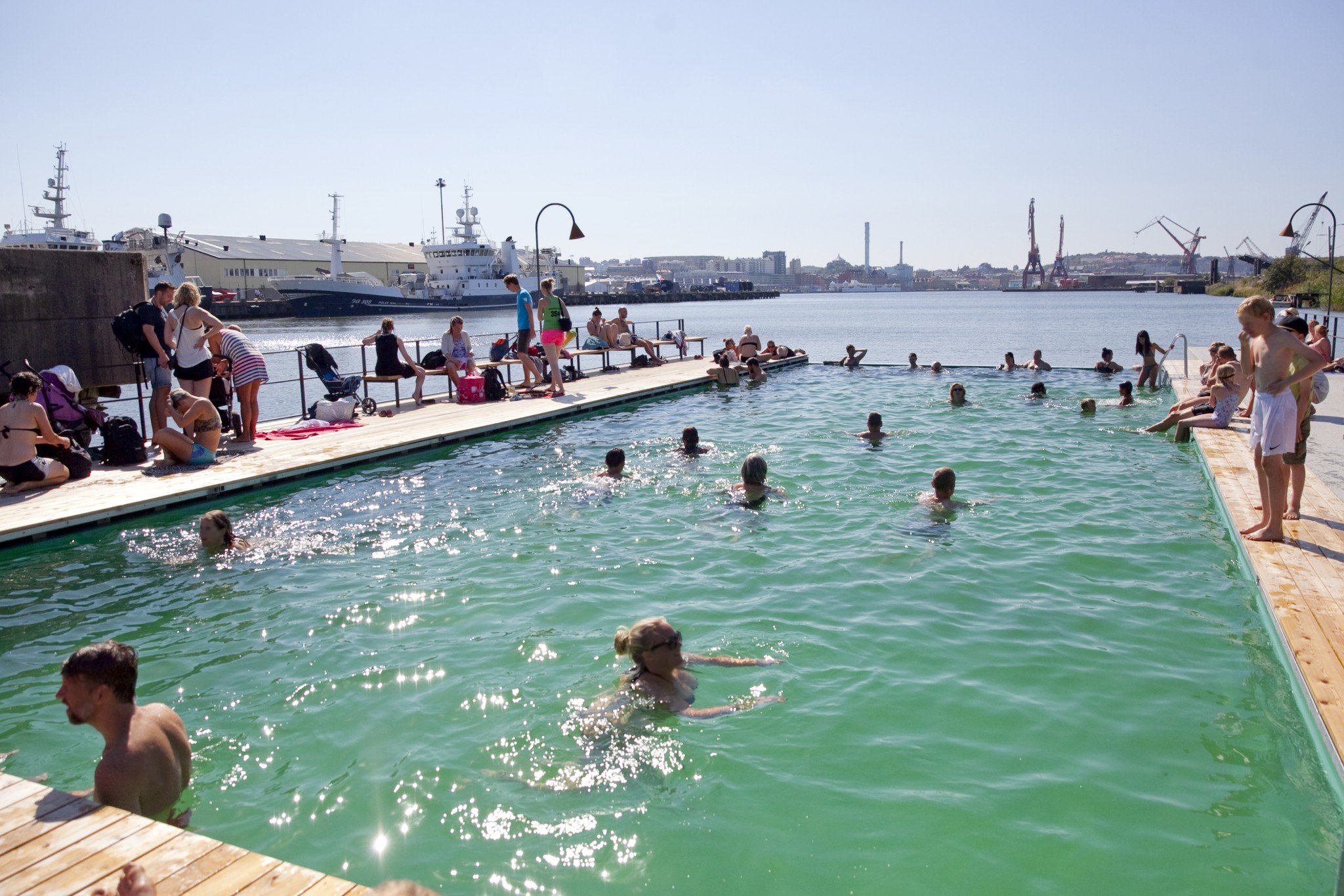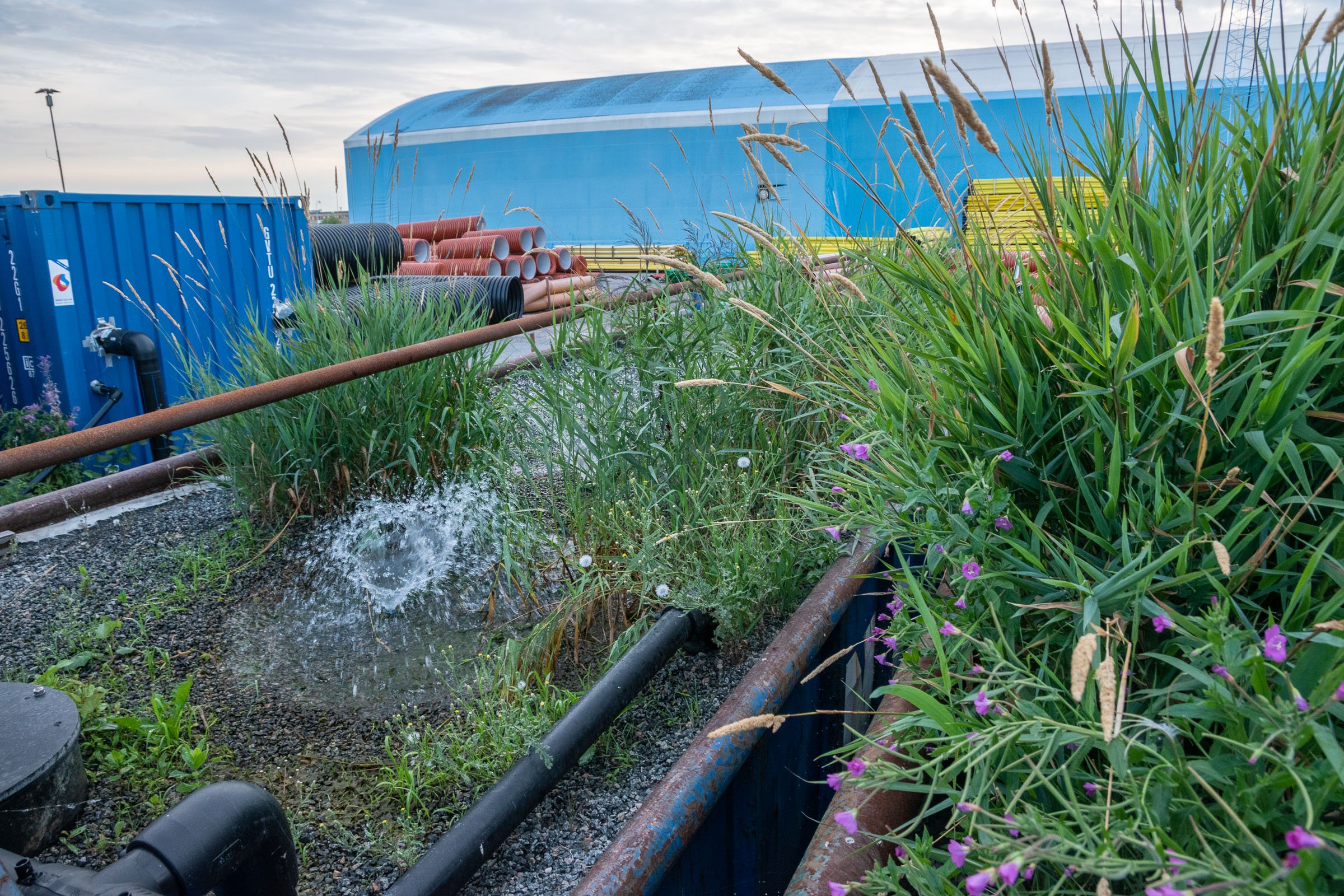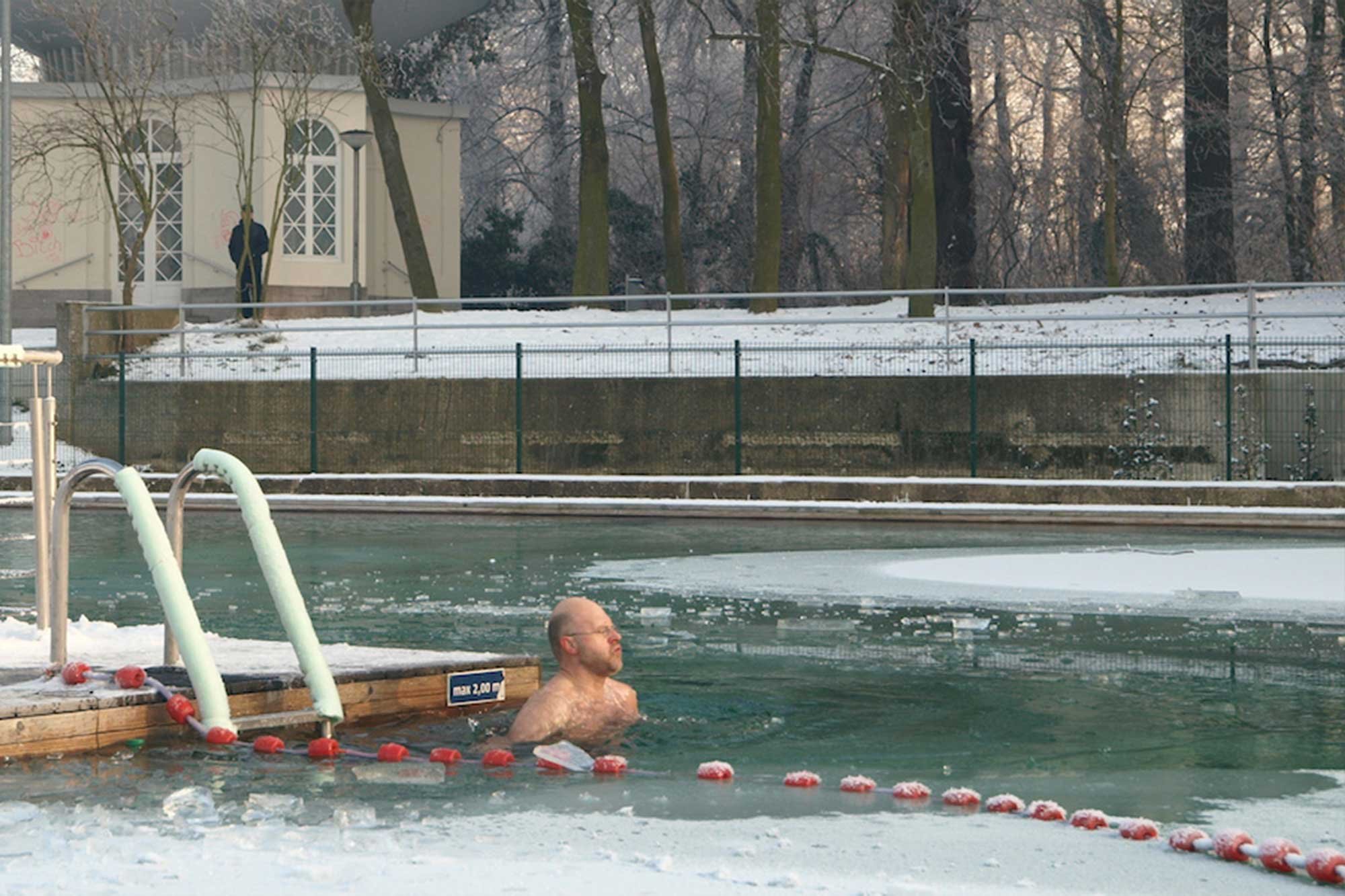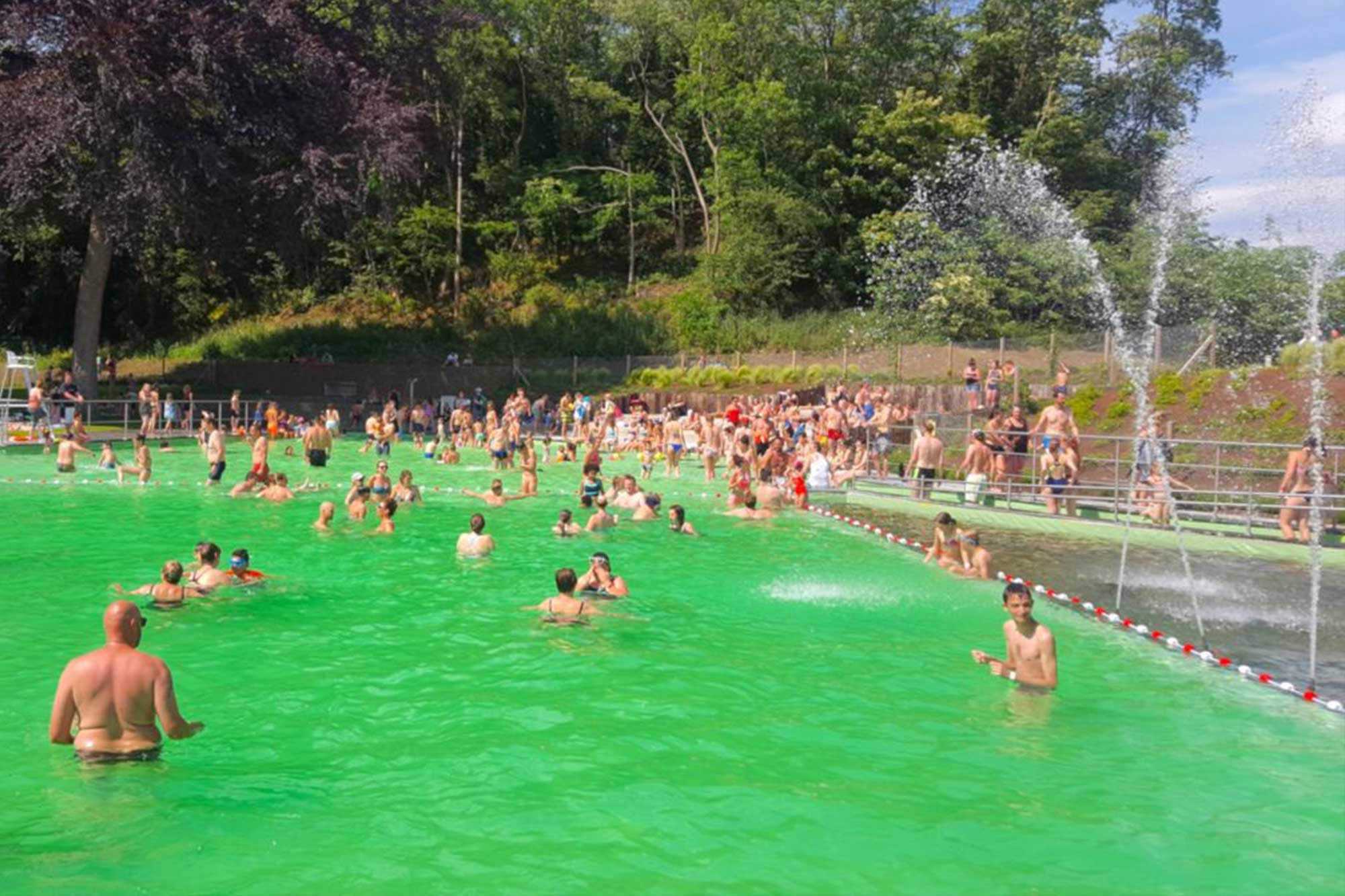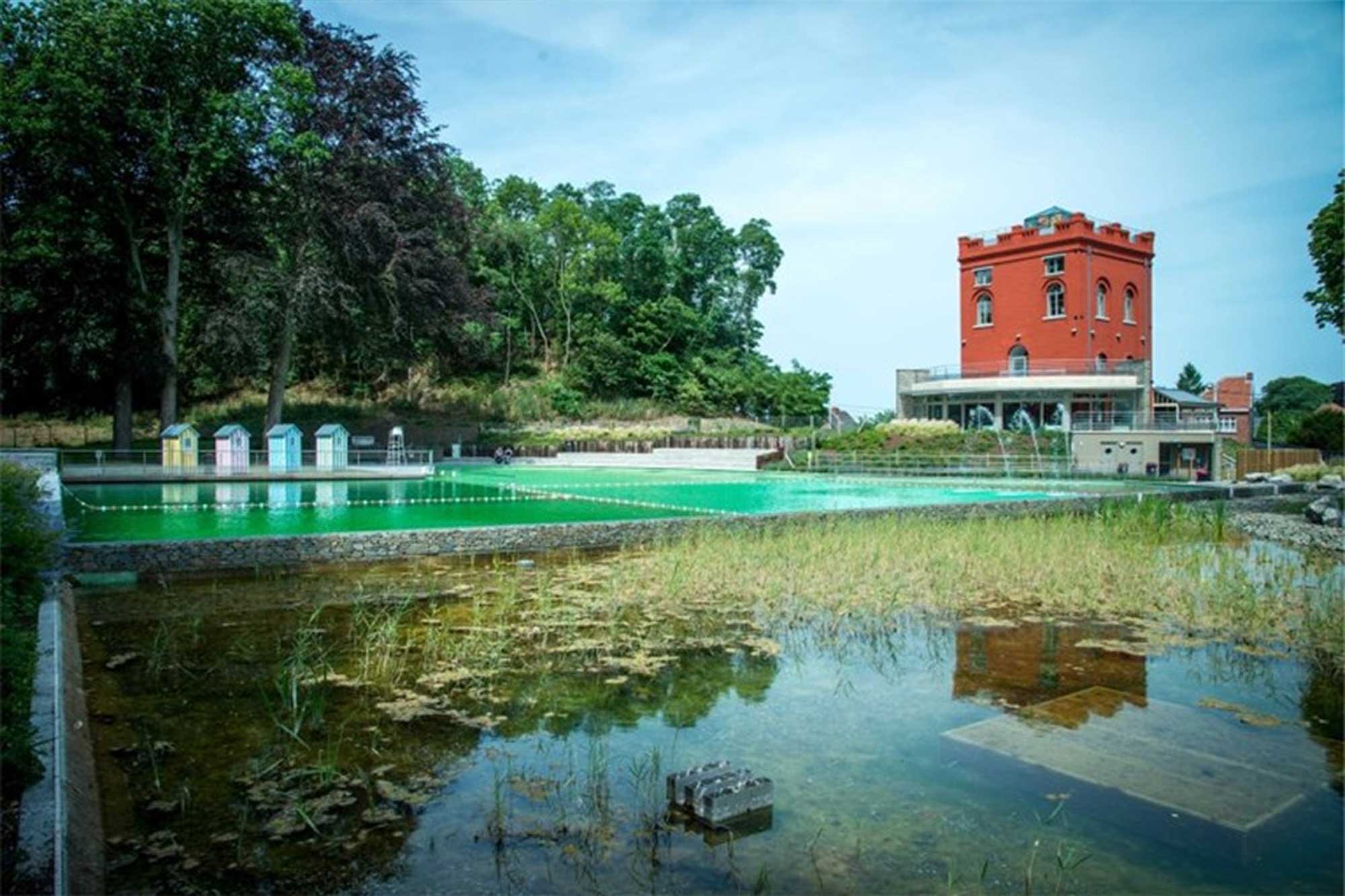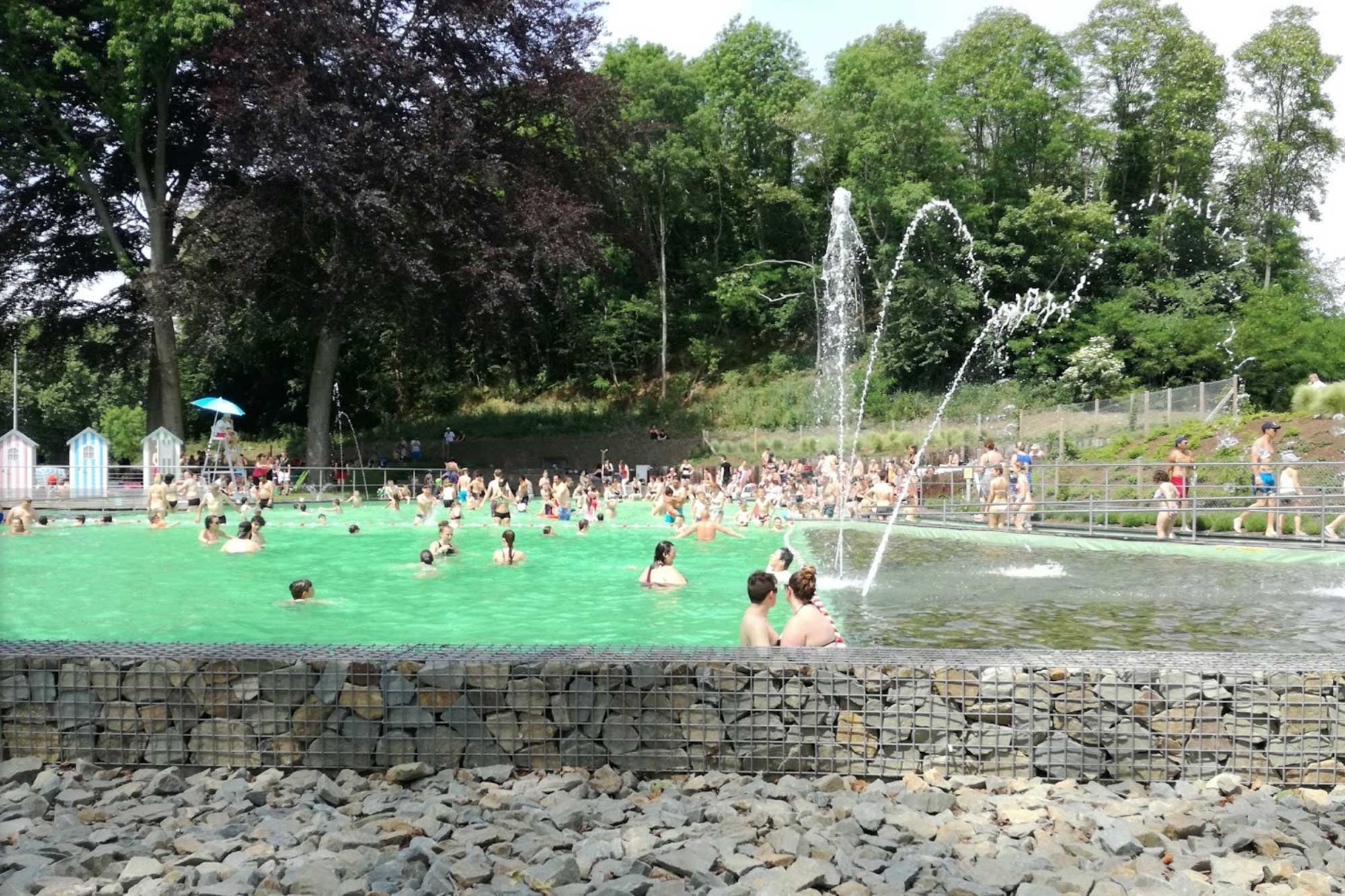THE BIOLOGICAL WATER TREATMENT AT FLOW
EN
The plant filters at the Pöl Harbor swimming pool in Gothenburg.
THE FIRST BIOLOGICAL POOL IN BRUSSELS
From the very beginning of FLOW, an ecological way of treating water was one of POOL IS COOL's main ambitions. For us, FLOW is not a solution to the acute shortage of swimming water in Brussels, but rather a prototype to demonstrate that it is indeed possible to properly manage an open-air swimming pool in Brussels. On the other hand, FLOW offers the opportunity to investigate what open-air swimming in Brussels could look like in the 21st century: What socio-economic role can it play? How does it respond to the hyper-diversity of Brussels? And how can outdoor swimming be safe and sustainable at the same time?
We are happy to finally be able to explore the sustainability aspect further in 2023 by transforming FLOW into the first swimming pool with biological water treatment in Brussels. The water at FLOW will no longer be treated chemically with chlorine, but with biological filters where plants and micro-organisms guarantee good water quality! This is possible thanks to a new Brussels Government decision on the operation of swimming pools, in force since March 2023.
After numerous comparable swimming pools with biological water treatment throughout the world, including in Flanders (Zwemvijver Boekenberg in Antwerp) or Wallonia (Piscine Belvédère in Dour), we believe it is time for Brussels too to take a step towards sustainable water treatment. To this end, FLOW can serve as a model for governments and administrations to gain hands-on experience for future projects such as the swimming area in Neerpede Park!
How does biological water treatment work?
In a classic swimming pool, and thus also at FLOW in 2021 and 2022, the water is first cleaned with a sand filter to filter out all suspended particles, and then disinfected with chlorine. Chlorine is a corrosive chemical that is automatically dosed into the water in public swimming pools and kills all bacteria, thus disinfecting the water. It can only be used with great caution (safety clothing) and should not be released into the environment. Disinfection with chlorine only works if the water has a certain pH value (the acidity of the water). The chlorine itself changes this value, therefore it must be counteracted by the addition of sulphuric acid to the bathing water. This system of chemical water treatment has long been known and works very well in most swimming pools around the world. But today it is also possible to guarantee water quality completely without chemicals! This is not only better for the environment, but also for many people who are sensitive to chlorine in the water. Thanks to biological water treatment, they too can enjoy outdoor swimming along with everyone else in natural swimming water.
Swimming pool
Water flows out of the pool via skimmers, removing floating impurities from the water surface
In the ‘hydrobotanica’ filter the water is enriched with oxygen from the water plants
Water seeps through a layer of substrate and is collected in drainage pipes
Via a pump in a technical shaft the water flows to the next containers
In reality there are two ‘neptune’ filters. Water is spread over the substrate via spray nozzles
Water seeps through the substrate, passing the biofilm of microorganisms on the grains that purifies the water biologically
Roots of plants in the substrate keep the pores open
Water is collected via drainage pipes and flow to the pump
Via the pump the water flows back to the swimming pool
Through nozzles all around the pool the cleaned water enters the pool again
click on the picture for a larger view
In a swimming pool with biological water treatment, the water circulates between the pool and the biological filters. In the case of FLOW, these filters are realised in 3 big sea containers that will be located next to FLOW, of which the roof has been removed.
One of the filters we call 'hydrobotanics', a container filled with water that flows from the pool into the filter. Aquatic plants grow in this filter, providing oxygen to the water while consuming nutrients from the water that are thus unavailable to algae in the pool, thus inhibiting their growth.
The other two containers, called 'neptune filters', are filled with a gravel substrate. This gravel is made of a specific mineral called "oolith" that can bind nutrients such as phosphate and nitrate from the water to also minimise algae growth.
The oxygenated water from the first container is pumped to the other two containers and distributed above the substrate with nozzles. The water then seeps down through the substrate. A biofilm of micro-organisms grows on the numerous grains in the substrate, removing harmful bacteria from the swimming water. To do this, they need oxygen. Plants also grow in the substrate of these two containers. The growth of their roots keeps the pores between the grains open and allows water to seep through. At the same time, they too consume nutrients. The water is collected at the bottom of the containers in drainage pipes and returns to the pool, the cycle begins again.
In a pool with chemical water treatment, the entire water of the pool (in FLOW about 160 m3) circulates through filters and disinfection all 90 minutes, 16 times a day. With biological water treatment, this happens much less, only 2-3 times a day. Therefore, plant filters also have much lower energy consumption than conventional filters.
Borden Park Pool, Edmonton, Canada
GH3 architecture with Polyplan Kreikenbaum
(hover over the picture for details)
Pöl Harbor @ Jubileumsparken, Gothenburg, Sweden
Raumlabor with Polyplan Kreikenbaum
Boekenberg Swimming Pond, Antwerp, Belgium
Piscine Belvédère, Dour, Belgium
But plant filters also have limitations, this is in their nature. First, plant filters require much more space than chemical water treatment filters. In the case of FLOW, there are three 20ft sea containers covering an area of about 45 m2, which is more than one-third of the pool itself.
More importantly, in a biological water treatment system, the filters together with the pool form a closed ecosystem with plants and microorganisms. This system can be calculated in advance to match the expected average capacity of a pool, but it cannot respond as well to varying visitor numbers as a pool with chemical water treatment. In case of the latter, one only has to turn the chlorine tap further open when there are more swimmers. In a swimming pool with biological water treatment, the capacity is fixed in advance. For a brief moment the average capacity may be exceeded, on very hot days for example, but after that the water treatment ecosystem needs rest to recuperate.
Swimming Pond Boekenberg, Antwerp - © Koen Cobbaert
What should you consider when swimming in a natural pool?
You should be aware that you are not swimming in a sterile classical pool with chlorinated water, but in an ecosystem similar to a natural pond or lake. This has several consequences:
While the water should always be clear, it can have a green tinge from microscopic algae. Look at the photo of the swimming pond in Boekenberg. This has no impact on water quality!
As a swimmer, it is incredibly important to put as little strain on the water as possible. Therefore, this year we are paying even more attention to two important ground rules: Everyone is required to shower before swimming. And only swimwear is allowed in the water, certainly no underwear. And yes, when in doubt, we will actually check this!
FLOW plant filters are a biological habitat and ecologically balanced. This balance is sensitive to chemical influences such as sunscreen. But sun protection is important! Fortunately enough, ecologically acceptable sunscreens do exist, with mineral UV filters. At FLOW, we will therefore offer environmentally friendly sunscreen free of charge.
We have yet to gain experience with the behaviour of the filters. We are therefore limiting the time to reserve a swim for FLOW in advance to 24h (as opposed to 72h or three days in the last two years). This will allow us to be quicker on the ball if a capacity adjustment is needed, and disappoint fewer people in case of reduction. We reserve the right to adjust this measure in due course if necessary.
While there are many public natural swimming pools around the world, it is a first for Brussels and for us. We are curious to see how this summer will go and look forward to your feedback!
POOL IS COOL works with experienced partners
The transformation of FLOW into a natural swimming pool is a radical change and would not be possible without the expertise of two experienced partners to make it happen in a reliable way:
Polyplan Kreikenbaum is an engineering company from Bremen in Germany that has already realised more than a hundred publicly accessible swimming ponds and natural pools, including in Switzerland, Sweden, Denmark, Poland, Canada, Germany of course, and soon, alongside FLOW, in Belgium. Take a look at their impressive list of reference projects. They are responsible for the biological and technical concept of the plant filters and automatic control.
The filters are realised by Ecoworks from Vilvoorde. In Belgium, they were responsible for the construction of several natural swimming pools for the general public, such as the swimming pond of the LAGO swimming pool in Sint-Truiden or the Waerwaters swimming pond in Dilbeek, very close to Brussels. Ecoworks was already responsible for the construction of the FLOW swimming pond in 2021. Now they can finally apply their real expertise to FLOW's biological plant filters.
FLOW is supported by the Brussels Government, the Flemish Government, the VGC, Bruxelles Environnement, Bruxelles Mobilité, urban.brussels, the Port of Brussels and the Commune of Anderlecht.
FR
LE TRAITEMENT BIOLOGIQUE DE L'EAU À FLOW
Les filtres végétaux de la piscine de Pöl Harbor à Göteborg.
LA PREMIÈRE PISCINE BIOLOGIQUE À BRUXELLES
Dès la conception de FLOW, le traitement écologique de l'eau a été l'une des principales ambitions de POOL IS COOL. Pour nous, FLOW n'est pas une solution à la pénurie aiguë d'eau de baignade à Bruxelles, mais plutôt un prototype pour démontrer qu'il est tout à fait possible de gérer correctement une piscine en plein air à Bruxelles. D'autre part, il s'agit d'étudier à quoi pourrait ressembler la baignade en plein air à Bruxelles au 21e siècle : Quel rôle socio-économique peut-elle jouer ? Comment répond-elle à l'hyperdiversité de Bruxelles ? Et comment la baignade en plein air peut-elle être à la fois sûre et durable ?
Nous sommes heureux de pouvoir enfin approfondir l'aspect “durabilité” en 2023 en transformant FLOW en première piscine avec traitement biologique de l'eau à Bruxelles. L'eau de FLOW ne sera plus traitée chimiquement avec du chlore, mais avec des filtres biologiques où des plantes et des micro-organismes garantissent la qualité de l'eau ! Ceci est possible grâce à une nouvelle décision du gouvernement bruxellois relative à l'exploitation des piscines, en vigueur depuis mars 2023.
Après de nombreuses piscines comparables équipées d'un traitement biologique de l'eau à travers le monde, notamment en Flandre (Zwemvijver Boekenberg à Anvers) ou en Wallonie (Piscine Belvédère à Dour), nous pensons qu'il est temps pour Bruxelles de faire un pas vers un traitement durable de l'eau. À cette fin, FLOW nous offre l'opportunité, ainsi qu'aux gouvernements et aux administrations, d'acquérir une expérience pratique pour de futurs projets tels que la zone de baignade du parc Neerpede !
Comment fonctionne le traitement biologique de l'eau ?
Dans une piscine classique, et donc également au FLOW en 2021 et 2022, l'eau est d'abord nettoyée à l'aide d'un filtre à sable, de sorte que toutes les particules en suspension sont filtrées, puis elle est désinfectée au chlore. Le chlore est un produit chimique corrosif qui est automatiquement dosé dans l'eau des piscines publiques et qui tue toutes les bactéries, désinfectant ainsi l'eau. Il ne peut donc être utilisé qu'avec une grande prudence (vêtements de sécurité) et ne doit pas être rejeté dans l'environnement. La désinfection au chlore ne fonctionne que si l'eau a un certain pH (acidité de l'eau). Le chlore lui-même modifie cette valeur, c'est pourquoi il doit être contrebalancé par l'ajout d'acide sulfurique dans l'eau de baignade. Ce système de traitement chimique de l'eau est connu depuis longtemps et fonctionne très bien dans la plupart des piscines du monde. Mais aujourd'hui, il est également possible de garantir la qualité de l'eau sans aucun produit chimique ! C'est non seulement meilleur pour l'environnement, mais aussi pour de nombreuses personnes sensibles au chlore dans l'eau. Grâce au traitement biologique de l'eau, elles peuvent elles aussi profiter de la baignade en plein air, comme tout le monde, dans une eau de baignade naturelle.
Piscine
L'eau s'écoule de la piscine par des écumoires qui éliminent les impuretés flottantes à la surface de l'eau.
Dans le filtre "hydrobotanica", l'eau est enrichie en oxygène par les plantes aquatiques.
L'eau passe à travers une couche de substrat et est recueillie dans des tuyaux de drainage.
L'eau est transportée par une pompe située dans une gaine technique jusqu'aux conteneurs suivants.
En effet, il y a deux filtres "neptune". L'eau est diffusée sur le substrat par des buses de pulvérisation.
L'eau traverse le substrat et passe à travers le biofilm de micro-organismes sur les grains qui purifient l'eau biologiquement.
Les racines des plantes présentes dans le substrat maintiennent les pores ouverts.
L'eau est collectée par des tuyaux de drainage et s'écoule vers la pompe.
Via la pompe, l'eau retourne dans la piscine.
L'eau nettoyée retourne dans la piscine par des buses situées tout autour de la piscine.
cliquez sur l'image pour l'agrandir
Dans une piscine avec traitement biologique de l'eau, l'eau circule entre le bassin et les filtres biologiques. Dans FLOW, ces filtres sont réalisés dans 3 conteneurs maritimes qui seront situés à côté de FLOW, dont le toit a été enlevé.
L'un des filtres que nous appelons "hydrobotanique" est un récipient rempli d'eau qui s'écoule depuis la piscine vers le filtre. Des plantes aquatiques poussent dans ce filtre, fournissant de l'oxygène à l'eau tout en consommant les nutriments de l'eau qui ne sont donc pas disponibles pour les algues de la piscine, ce qui inhibe leur croissance.
Les deux autres récipients, appelés "filtres neptune", sont remplis d'un substrat de gravier. Ce gravier est composé d'un minéral spécifique appelé "oolithe" qui peut fixer les nutriments tels que le phosphate et le nitrate présents dans l'eau, afin de minimiser la croissance des algues.
L'eau oxygénée du premier conteneur est pompée dans les deux autres conteneurs et distribuée au-dessus du substrat à l'aide de buses. L'eau s'infiltre ensuite dans le substrat. Un biofilm de micro-organismes se développe sur les nombreux grains du substrat et élimine les bactéries nocives de l'eau de baignade. Pour ce faire, ils ont besoin d'oxygène. Des plantes poussent également dans le substrat de ces deux conteneurs. La croissance de leurs racines maintient les pores entre les grains ouverts et permet à l'eau de s'infiltrer. En même temps, elles consomment elles aussi des nutriments. L'eau est recueillie au fond des bacs dans des tuyaux de drainage et retourne dans le bassin, le cycle recommence.
Dans une piscine avec traitement chimique de l'eau, toute l'eau de la piscine, dans un débit d'environ 160 m3, circule à travers les filtres et la désinfection pendant 90 minutes, soit 16 fois par jour. Avec un traitement biologique de l'eau, cela se produit beaucoup moins souvent, seulement 2 à 3 fois par jour. Par conséquent, les filtres végétaux ont également une consommation d'énergie beaucoup plus faible que les filtres conventionnels.
Borden Park Pool, Edmonton, Canada
GH3 architecture avec Polyplan Kreikenbaum
(passez la souris sur l'image pour plus de détails)
Étang de baignade Boekenberg, Anvers, Belgique
Pöl Harbor @ Jubileumsparken, Gothenburg, Suède
Raumlabor avec Polyplan Kreikenbaum
Piscine Belvédère, Dour, Belgique
Mais les filtres végétaux ont aussi des limites, c'est dans leur nature. Tout d'abord, les filtres végétaux nécessitent beaucoup plus d'espace que les filtres de traitement chimique de l'eau. Dans le cas de FLOW, il s'agit de trois conteneurs maritimes de 20 pieds, soit une surface d'environ 45 m2. Cela représente plus d'un tiers de la piscine elle-même.
Plus important encore, dans un système de traitement biologique de l'eau, les filtres et la piscine forment un écosystème fermé avec des plantes et des micro-organismes. Ce système peut être calculé à l'avance pour correspondre à la capacité moyenne attendue d'une piscine, mais il ne peut pas réagir aussi bien aux variations du nombre de visiteurs qu'une piscine équipée d'un traitement chimique de l'eau. Dans ce cas, il suffit d'ouvrir davantage le robinet de chlore lorsqu'il y a plus de baigneurs. Dans une piscine avec traitement biologique de l'eau, la capacité est fixée à l'avance. Pendant un court moment, la capacité moyenne peut être dépassée, par exemple lors de journées très chaudes, mais ensuite l'écosystème de traitement de l'eau a besoin de se reposer pour récupérer.
Étang de baignade, Boekenberg, Anvers - © Koen Cobbaert
Que faut-il prendre en compte lorsque l'on se baigne dans une piscine naturelle ?
Vous devez savoir que vous ne nagez pas dans une piscine classique stérile avec de l'eau chlorée, mais dans un écosystème semblable à un étang ou un lac naturel. Cela a plusieurs conséquences :
Bien que l'eau doive toujours être claire, elle peut avoir une teinte verte due à des algues microscopiques. Regardez la photo de l'étang de baignade de Boekenberg. Cela n'a aucune incidence sur la qualité de l'eau !
En tant que nageur, il est extrêmement important de solliciter l'eau le moins possible. C'est pourquoi, cette année, nous accordons encore plus d'attention à deux règles de base importantes : Tout le monde doit se doucher avant de nager. Et seuls les maillots de bain sont autorisés dans l'eau, certainement pas les sous-vêtements. Et oui, en cas de doute, nous le vérifierons !
Les filtres végétaux FLOW constituent un habitat biologique et un équilibre écologique. Cet équilibre est sensible aux influences chimiques telles que la crème solaire. Mais la protection solaire est importante ! Heureusement, il existe des crèmes solaires acceptables d'un point de vue écologique, qui contiennent des filtres UV minéraux. C'est pourquoi nous proposons gratuitement à FLOW une crème solaire respectueuse de l'environnement.
Nous n'avons pas encore acquis d'expérience en ce qui concerne le comportement des filtres. C'est pourquoi nous limitons à 24 heures (contre 72 heures ou trois jours ces deux dernières années) le délai de réservation à l'avance d'une baignade pour FLOW. Cela nous permettra d'être plus réactifs en cas d'ajustement de la capacité et de décevoir moins de personnes en cas de réduction. Nous nous réservons le droit d'ajuster cette mesure en temps voulu si nécessaire.
Bien qu'il existe de nombreuses piscines naturelles publiques dans le monde, c'est une première pour Bruxelles et pour nous. Nous sommes curieux de voir comment se déroulera l'été prochain et nous attendons avec impatience vos commentaires !
POOL IS COOL travaille avec des partenaires expérimentés
La transformation de FLOW en piscine naturelle est un changement radical qui n'aurait pas été possible sans l'expertise de deux partenaires expérimentés pour y parvenir de manière optimale :
Polyplan Kreikenbaum est un bureau d'études de Brême, en Allemagne, qui a déjà réalisé plus d'une centaine d'étangs de natation et de piscines naturelles accessibles au public, notamment en Suisse, en Suède, au Danemark, en Pologne, au Canada, en Allemagne bien sûr, et bientôt, aux côtés de FLOW, en Belgique. Jetez un coup d'œil à leur impressionnante liste de projets de référence. Ils sont responsables du concept biologique et technique des filtres de l'installation et du contrôle automatique.
Les filtres sont réalisés par Ecoworks de Vilvoorde. En Belgique, ils ont été chargés de la construction de plusieurs piscines naturelles pour le grand public, comme l'étang de la piscine LAGO à Saint-Trond ou l'étang de Waerwaters à Dilbeek, tout près de Bruxelles. Ecoworks était déjà responsable de la construction de la piscine FLOW en 2021. Aujourd'hui, ils peuvent enfin appliquer leur véritable expertise aux filtres biologiques de FLOW.
FLOW est possible grâce au soutien du Gouvernement Bruxellois, du Gouvernement Flamand, de la VGC, de Bruxelles Environnement, de Bruxelles Mobilité, de urban.brussels, du Port de Bruxelles et de la Commune d'Anderlecht.
NL
DE BIOLOGISCHE WATERZUIVERING VAN FLOW
De plantenfilters van het Pöl Harbor zwembad in Gotenburg.
HET EERSTE BIOLOGISCHE ZWEMBAD IN BRUSSEL
Reeds vanaf het begin van FLOW was een ecologische manier van waterzuivering een van de hoofdambities van POOL IS COOL. Voor ons is FLOW geen oplossing voor het nijpende gebrek aan zwemwater in Brussel, maar vooral een prototype om langs de ene kant aan te tonen dat het überhaupt mogelijk is om een openluchtzwembad in Brussel degelijk te beheren. En langs de andere kant om te onderzoeken hoe openluchtzwemmen in Brussel in het 21e eeuw eruit kan zien: Welke socio-economische rol kan het spelen? Hoe speelt het in op de hyperdiversiteit van Brussel? En hoe kan openluchtzwemmen veilig en tegelijkertijd duurzaam zijn?
Wij zijn blij dat wij in 2023 eindelijk het duurzaamheidsaspect verder kunnen onderzoeken door FLOW om te vormen tot het eerste zwembad met biologische waterbehandeling in Brussel. Het water van FLOW wordt niet langer chemisch met chloor gezuiverd, maar met biologische filters waar planten en microorganismes de waterkwaliteit garanderen! Dit is mogelijk dankzij een nieuw besluit van de Brusselse Regering over de uitbating van zwembaden, van kracht sinds maart 2023.
Na talloze vergelijkbare zwembaden met biologische waterzuivering in de hele wereld, waaronder ook in Vlaanderen (Zwemvijver Boekenberg in Antwerpen) of Wallonie (Piscine Belvédère in Dour) wordt het volgens ons tijd dat ook Brussel een stap richting duurzame waterbehandeling maakt. FLOW biedt hiervoor de kans voor ons, overheden en administraties om hands-on ervaring op te doen voor toekomstige projecten zoals de zwemzone in het Park van Neerpede!
Hoe werkt biologische waterbehandeling?
In een klassiek zwembad, en dus ook bij FLOW in 2021 en 2022, word het water eerst met een zandfilter gereinigd, dus alle zwevende deeltjes worden uitgefilterd, en vervolgens gebeurt de desinfectie met chloor. Chloor is een bijtende chemische stof die in publieke zwembaden automatisch gedoseerd aan het water wordt toegevoegd en alle bacterien dodt en zo het water desinfecteerd. Het is daarom ook enkel met veel voorzicht (veiligheidskledij) te hanteren en mag niet in het milieu terechtkomen. De desinfectie met kloor werkt enkel als het water een bepaalde pH waarde heeft (de zuurtegraad van het water). Het chloor zelf verandert deze waarde, daarom moet worden tegengestuurd door de toevoeging van zwavelzuur aan het zwemwater. Dit systeem van chemische waterbehandeling is al lang gekend en werkt heel goed in de meeste zwembaden in de hele wereld. Maar vandaag is het ook mogelijk om helemaal zonder chemicalien de waterkwaliteit te garanderen! Dit is niet enkel beter voor het milieu, maar ook voor vele mensen de gevoelig zijn aan chloor in het water. Dankzij biologische waterbehandeling kunnen ook zij van openluchtzwemmen genieten, samen met iedereen in natuurlijk zwemwater.
Zwembad
Het water stroomt uit het zwembad via skimmers, die drijvende onzuiverheden van het wateroppervlak verwijderen
In het 'hydrobotanica'-filter wordt het water verrijkt met zuurstof uit de waterplanten
Water seeps through a layer of substrate and is collected in drainage pipes
Water sijpelt door een laag substraat en wordt opgevangen in drainagebuizen
In feite zijn er twee 'neptune'-filters. Water wordt via sproeiers over het substraat verspreid
Water sijpelt door het substraat en passeert de biofilm van micro-organismen op de korrels die het water biologisch zuivert
Wortels van planten in het substraat houden de poriën open
Water is collected via drainage pipes and flow to the pump
Water wordt opgevangen via afvoerbuizen en stroomt naar de pomp
Via sproeiers rondom het zwembad komt het gereinigde water weer in het zwembad terecht
klik op de afbeelding voor een grotere weergave
In een zwembad met biologische waterbehandeling circuleert het water tussen de badkuip en de biologische filters. In FLOW zijn deze filters gerealiseerd in 3 zeecontainers die naast FLOW komen te staan en bij welke het dak werd verwijderd.
Een van de filters noemen wij ‘hydrobotaniek’, het is een containerdie gevuld is met water dat uit het zwembad naar de filter stroomt. In deze filter groeien waterplanten die zuurstof aan het water geven en tegelijkertijd nutrienten uit het water verbruiken die zo niuet ter beschikking staan voor algen in het zwembad, hun groei wordt dus geremd.
De twee andere containers, genoemd ‘neptunfilters’, zijn gevuld met een substraat uit grind. Deze grind is gemaakt van een specifiek mineraal genoemd “oolith” dat nutrienten zoals fosfaat en nitraat uit het water kan binden om eveneens de algengroei te minimeren.
Het zuurstofrijke water uit de eerste container word met een pomp naar de twee andere containers gebracht en boven het substraat verdeeld met sproeiers. Het water sijpeltd dan door het substraat naar beneden. Op de talloze korrels in het substraat groeit een biofilm van micgroorganismes die de schadelijke bacterien uit het zwemwater verwijderen. Hiervoor hebben zij de zuurstof nodig. Ook in het substraat van deze twee containers groeien planten. De groei van hun wortels zorgt ervoor dat de porien tussen de korrels open blijven en water erdoor kan sijpelen. Tegelijkertijd verbruiken ook zij nutrienten. Het water wordt op de bodem van de containers opgevangen in drainagebuizen en gaat terug naar het zwembad, de cyclus begint opnieuw.
In een zwembad met chemische waterbehandeling circuleert het hele water van het zwembad, in FLOW ca. 160 m3, alle 90 minuten door filters en desinfectie, 16 keer per dag. Met een biologische waterbehandeling gebeurt dit veel minder, slechts 2 à 3 keer per dag. Daarom hebben plantenfilters ook een veel lager energieverbruik dan klassieke filters.
Borden Park Pool, Edmonton, Canada
GH3 architectuur met Polyplan Kreikenbaum
(beweeg de muis over de afbeelding voor meer informatie)
Zwemvijver Boekenberg, Antwerp, België
Pöl Harbor @ Jubileumsparken, Gothenburg, Zweden
Raumlabor met Polyplan Kreikenbaum
Zwembad Belvédère, Dour, Belgiê
Maar plantenfilters hebben ook beperkingen, dit zit in hun aard. Ten eerste hebben de plantenfilters veel meer plaats nodig dan de filters van een chemische waterbehandeling. In het geval van FLOW zijn het drie 20ft-zeecontainers, dus een oppervlakte van ca. 45 m2. Dat is meer dan één derde van het zwembad zelf.
Nog belangrijker is het feit dat bij een systeem van biologischen waterbehandeling de filters samen met het zwembad een gesloten ecosysteem vormen met planten en microorganismes. Dit systeem kan op voorhand worden berekend om het af te stemmen op de verwachte gemiddelde capaciteit van een zwembad, maar het kan niet zo goed reageren op wisselende bezoekersaantallen zoals een zwembad met chemische waterbehandeling. In dit geval draait men in principe gewoon de kraan van het chloor verder open als er meer zwemmers zijn. Bij een zwembad met biologische waterbehandeling ligt de capacieit op voorhand vast. Voor een kort moment kan de gemiddelde capaciteit worden overschreden, op zeer warme dagen bijvoorbeeld, maar daarna heeft het ecosysteem van de waterbehandeling rust nodig om te recupereren.
Zwemvijver Boekenberg, Antwerpen - © Koen Cobbaert
Met wat moet je rekening houden als u in een natuurlijk zwembad zwemt?
Je moet je ervan bewust zijn dat je niet in een steriel klassiek zwembad met gechloreerd water zwemt, maar in een ecosysteem vergelijkbaar met een natuurlijke vijver of meer. Dit heeft verschillende consequenties:
Terwijl het water altijd helder moet zijn, kan het wel een groene tint van microskopische algen hebben. Kijk naar het foto van de zwemvijver in Boekenberg. Dit heeft geen impact op de waterkwaliteit!
Als zwemmer is het ontzettend belangrijk om het water zo min mogelijk te belasten. Daarom besteden we dit jaar nog meer aandacht aan twee belangrijke basisregels: Iedereen is verplicht te douchen voor het zwemmen. En alleen zwemkleding is toegestaan in het water, zeker geen ondergoed. En ja, bij twijfel zullen we dit ook echt controleren!
De plantenfilters van FLOW zijn een biologisch habitaat en ecologisch in evenwicht. Dit evenwicht is gevoelig aan chemische invloeden zoals zonnecreme. Maar bescherming van de zon is belangrijk! Gelukkig genoeg bestaan er ecologisch aanvaardbare zonnecremes, deze met mineralische UV-filters. Aan FLOW zullen wij daarom gratis milieuvriendelijke zonnecreme aanbieden.
We moeten nog ervaring opdoen met het gedrag van de filters. Daarom beperken wij de tijd om een zwembeurt voor FLOW op voorhand te reserveren tot 24h (in tegenstelling tot 72h of drie dagen in de laatste twee jaren). Op die manier kunnen wij sneller op de bal spelen indien een aanpassing van de capaciteit nodig is, en stellen wij minder mensen teleur in geval van vermindering. We behouden ons voor om deze maatregel eventueel op termijn aan te passen.
Terwijl er vele publieke natuurzwembaden bestaan in de hele wereld is het een primeur voor Brussel en voor ons. We zijn benieuwd hoe de komende zomer zal verlopen en kijken uit naar jullie feedback!
POOL IS COOL werkt samen met ervaren partners
De transformatie van FLOW naar een natuurlijk zwembad is een ingrijpende verandering en zou niet mogelijk zijn zonder de expertise van twee ervaren partners om het op een betrwoubare manier te realiseren:
Polyplan Kreikenbaum is een ingenieursbureau uit Bremen in Duitsland dat al meer dan honderd publiek toegankelijke zwemvijvers en natuurlijke zwembaden heeft gerealiseerd, waaronder in Zwitserland, Zweden, Denemarken, Polen, Canada, Duitsland natuurlijk, en binnenkort ook, naast FLOW, in België. Kijk eens naar hun indrukwekkende lijst van referentieprojecten. Zij staan in voor het biologische en technische concept van de plantenfilters en de automatische sturing.
Gerealiseerd worden de filters door Ecoworks uit Vilvoorde. In Belgie stonden zij in voor de bouw van verschillende natuurlijke zwembaden voor het grote publiek, zoals de zwemvijver van het LAGO zwembad in Sint-Truiden of de zwemvijver van Waerwaters in Dilbeek, heel dichtbij Brussel. Ecoworks was in 2021 reeds voor de bouw van de zwemkuip van FLOW verantwoordelijk. Nu kunnen zij eindelijk hun echte expertise aanwenden voor de biologische plantenfilters van FLOW.
FLOW wordt mogelijk gemaakt door de steun van de Brusselse Regering, de Vlaamse Regering, de VGC, Leefmilieu Brussel, Brussel Mobiliteit, urban.brussels, de Haven van Brussel en de Gemeente Anderlecht.


